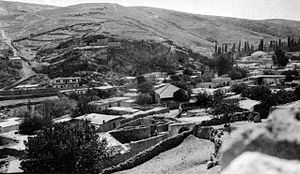
Back معركة عمان (الثانية) Arabic Bataille d'Amman (septembre 1918) French İkinci Amman Savaşı Turkish دوسری جنگ عمان Urdu
| Second Battle of Amman | |||||||
|---|---|---|---|---|---|---|---|
| Part of the Middle Eastern theatre of World War I | |||||||
 View across Amman to the Citadel | |||||||
| |||||||
| Belligerents | |||||||
|
| ||||||
| Commanders and leaders | |||||||
|
|
| ||||||
| Units involved | |||||||
|
| ||||||
The Second Battle of Amman was fought on 25 September 1918 during the Third Transjordan attack as part of the Battle of Nablus which together with the main Battle of Sharon form the major set piece offensive known as the Battle of Megiddo of the Sinai and Palestine Campaign in World War I. After cutting the road from Nablus to Es Salt on 22 September Chaytor's Force captured the bridge over the Jordan River at Jisr ed Damieh while units of the Seventh Army and remnants of the Eighth Army were still in retreating towards the bridge from the Judean Hills. Having cut this line of retreat, Chaytor's Force proceeded eastwards to attack and capture Es Salt, before riding on to attack and capture the Ottoman rearguard of the Fourth Army defending Amman. These British Empire victories of the Third Transjordan attack over Yildirim Army Group forces, followed two unsuccessful EEF attacks across the Jordan River in March and April 1918.
The Egyptian Expeditionary Force (EEF), commanded by General Edmund Allenby, began the Battle of Sharon in the early morning on the Mediterranean coast with attacks by the XXI Corps on the Eighth Ottoman Army followed by a breakthrough by the Desert Mounted Corps. Meanwhile, on their right the Battle of Nablus began with an attack by the XX Corps in the Judean Hills against the Asia Corps and sections of the Seventh Army defending Nablus, during the afternoon of 19 September once it became apparent the Battle of Sharon was succeeding, while Chaytor's Force held the extreme right flank in the Jordan Valley against the Fourth Ottoman Army and began their attacks northwards in the Jordan Valley to capture the Jisr ed Damieh bridge.
After leaving a detachment to hold the Jisr ed Damieh bridge and two other fords against any further retreating columns, Chaytor's Force advanced eastwards to attack and capture the garrisons at Shunet Nimrin and Es Salt. With the Fourth Army in retreat, they continued to Amman, where they attacked and captured a strong Ottoman rearguard of the Fourth Army's VIII Corps, which fought a determined action. Subsequently, Chaytor's Force accepted the surrender at Ziza of the Southern Force of the Fourth Army's II Corps, which had garrisoned the Hejaz Railway south from Amman to effectively end military operations in the area. Together these EEF victories during the Battle of Megiddo, resulted in the capture of the equivalent of one Ottoman army and many miles of territory, and forced the remnants of two armies to retreat in disarray.
© MMXXIII Rich X Search. We shall prevail. All rights reserved. Rich X Search